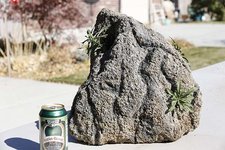I have had this chunk of feather rock kicking around for years. I am not an artist by any means and didn't really know what to do with it but finally decided to pull it our of a flower bed and give it a shot. The little bit of greenery you see there now is just to mark where the future trees will go. They are top left, high on the right (just barely seen) and bottom front right side. I am considering cotoneaster or juniper for next spring. All three hollowed out planting cavities are connected. Top left drains to top right and op right to bottom front an therer is a drainage hole from bottom front to the bottom.
Questions--- suggestions of potting soil? I am planning pumice, lava and oil dry (in place of akadama) I may add a little pine bark to the very top one.
Would there be a problem of tu cking a little spagnum moss around the openings to the planting cavities just to help keep the potting media in place and to hide the color difference of the pumice/lava a little
cking a little spagnum moss around the openings to the planting cavities just to help keep the potting media in place and to hide the color difference of the pumice/lava a little
Questions--- suggestions of potting soil? I am planning pumice, lava and oil dry (in place of akadama) I may add a little pine bark to the very top one.
Would there be a problem of tu
 cking a little spagnum moss around the openings to the planting cavities just to help keep the potting media in place and to hide the color difference of the pumice/lava a little
cking a little spagnum moss around the openings to the planting cavities just to help keep the potting media in place and to hide the color difference of the pumice/lava a little